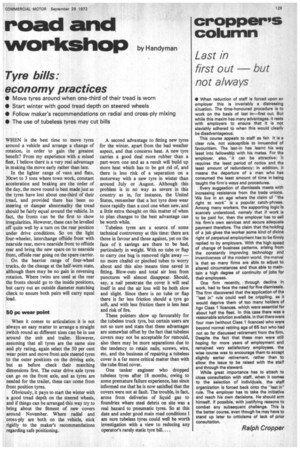road and workshop
Page 131

If you've noticed an error in this article please click here to report it so we can fix it.
Tyre bills: economy practices
• Move tyres around when one-third of their tread is worn • Start winter with good tread depth on steered wheels • Follow maker's recommendations on radial and cross-ply mixing • The use of tubeless tyres may cut bills by Handyman WHEN is the best time to •move tyres around a vehicle and arrange a change of rotation, in order to gain the greatest benefit? From my experience with a mixed fleet, I believe there is a very real advantage in making the move early rather than late.
In the lighter range of vans and flats, 30cwt to 3 tons where town work, constant acceleration and braking are the order of the day, the move round is best made just as the tyres have lost about one-third of their tread, and provided there has been no steering or damper abnormality the tread should be fairly equal around the vehicle. In fact, the fronts can be the first to show irregularities. However, these can be levelled off quite well by a turn on the rear position under drive conditions. So on the light four-wheeler, interchange offside front with nearside rear, move nearside front to offside rear and bring the new spare on to nearside front, offside rear going on the spare carrier.
On the heavier range of four-wheel trucks, do the change at the half-worn state, although there may be no gain in reversing rotation. Where twins are used at the rear the fronts should go to the inside positions, but carry out an outside diameter matching check to ensure both pairs will carry equal load.
50 pc wear paint When it comes to articulation it is not always an easy matter to arrange a straight switch round as different sizes can be in use around the unit and trailer. However, assuming that all tyres are the same size and ply rating, again select the 50 per cent wear point and move front axle steered tyres to the outer positions on the driving axle, but as before check their matching dimensions first. The outer drive axle tyres can go on the front axle, and as tyres are needed for the trailer, these can come from front position tyres.
Obviously, it pays to start the winter with a good tread depth on the steered wheels, and if things can be arranged this way try to bring about the fitment of new covers around November. Where radial and cross-ply are both on the vehicle, stick rigidly to the maker's recommendations regarding safe positioning. A second advantage to fitting new tyres for the winter, apart from the bad weather aspect, and that concerns heat. A new tyre carries a good deal more rubber than a part-worn one and as a result will build up more heat which has to be got rid of, and there is less risk of a separation on a motorway with a new tyre in winter than around July or August. Although this problem is in no way as severe in this country as in, for instance, the United States, remember that a hot tyre does wear more rapidly than a cool one when new, and a little extra thought on this matter of when to plan changes to the best advantage can be worth while.
Tubeless tyres are a source of some technical controversy at this time: there are those in favour and those against, yet on the face of it savings are there to be had, particularly in weight. With no tube or flap to carry one bug is removed right away — no more chafed or pinched tubes to worry about and this also means time saved in fitting. Blow-outs and total air loss from punctures will almost disappear. Should, say, a nail penetrate the cover it will seal itself in and the air loss will be both slow and slight. Since there is no tube or flap there is far less friction should a tyre go soft, and with less friction there is less heat and risk of fire.
These pointers show up favourably for the tubeless truck tyre, but certain users are not so sure and state that these advantages are somewhat offset by the fact that tubeless covers may not be acceptable for remould, also there may be more separations due to the tendency to retain nails, screws, wire, etc, and the business of repairing a tubeless cover is a far more critical matter than with the tube fitted cover.
One tanker engineer who dropped tubeless tyres after 18 months, owing to some premature failure experience, has since informed me that he is now satisfied that the covers were not at fault. The trouble, in fact, arose from deliveries of liquid gas to foundries where steel debris on site was a real hazard to pneumatic tyres. So at this date and under good main road conditions I am sure tubeless tyres could well be worth investigation with a view to reducing any operator's rarely static tyre bill....








































































































































































































































